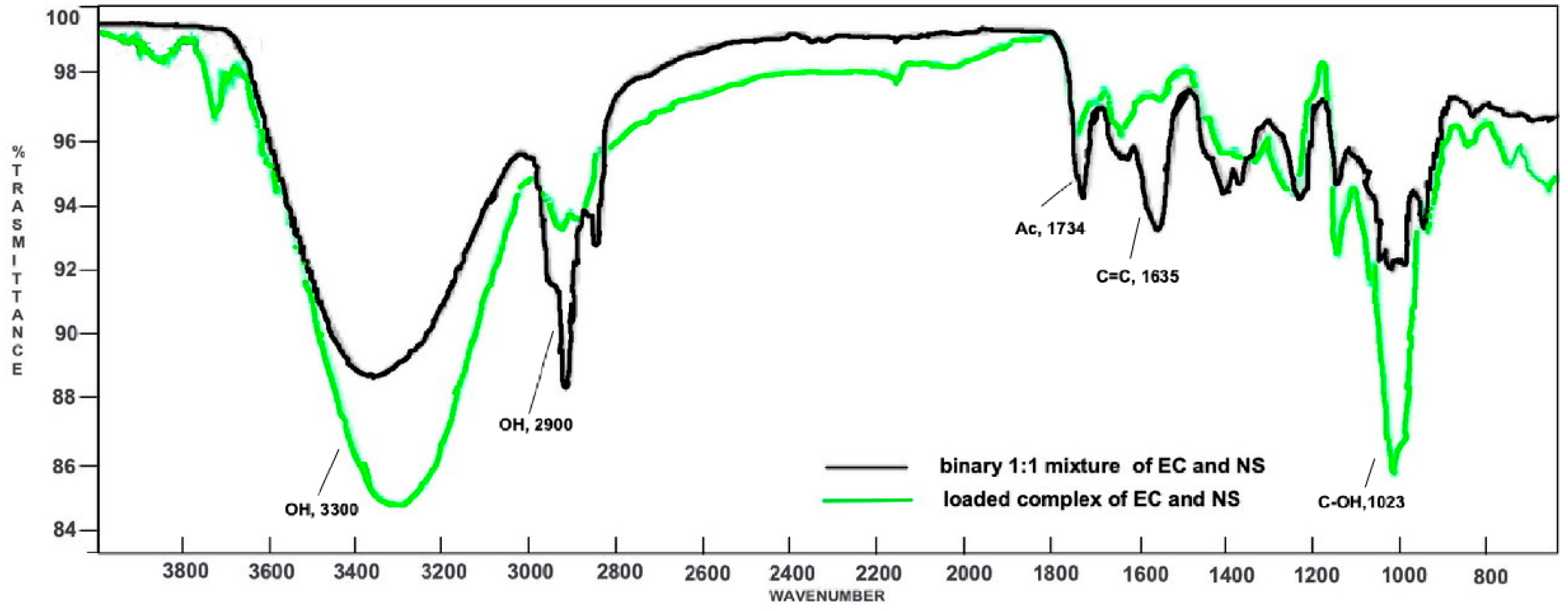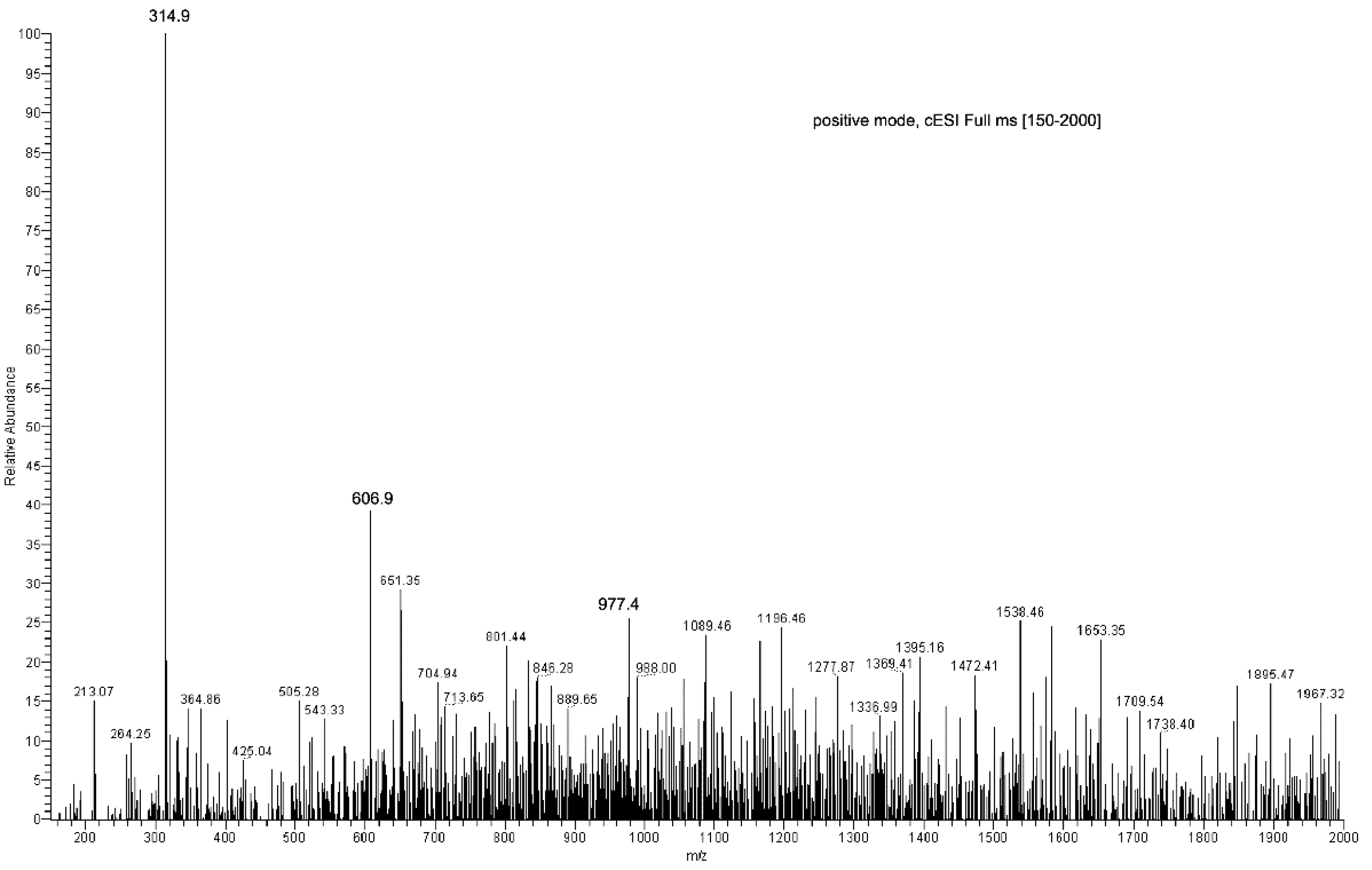Complexing the Marine Sesquiterpene Euplotin C by Means of Cyclodextrin-Based Nanosponges: A Preliminary Investigation
Abstract
1. Introduction
2. Results and Discussion
2.1. Attenuated Total Reflectance-Fourier Transform Infrared (ATR-FTIR) Studies
2.2. ESI-MS Studies
2.3. LC-PDA-ESI-MS Studies
2.4. Loading Efficiency and Loading Capacity of NS
3. Materials and Methods
3.1. Chemical Synthesis of β-CD-NS
3.2. Euplotin C Isolation from Cultures of Ciliated Strains
3.3. Euplotin C Purification from Organic Extracts
3.4. Preparation of Binary Mixture of EC and NS
3.5. Preparation of EC-loaded NS (EC-NS)
3.6. Recovery of EC from the Loaded NS
3.7. ESI-MS Analysis
3.8. LC-PDA-ESI-MS Analyses
3.9. Loading Efficiency and Loading Capacity of NS
4. Conclusions
Supplementary Materials
Author Contributions
Funding
Institutional Review Board Statement
Data Availability Statement
Conflicts of Interest
References
- Trielli, F.; Cervia, D.; Di Giuseppe, G.; Ristori, C.; Kruppel, T.; Burlando, B.; Guella, G.; Viarengo, A.; Bagnoli, P.; Umberta, M.; et al. Action mechanisms of the secondary metabolite euplotin C: Signaling and functional role in Euplotes. J. Eukaryot. Microbiol. 2008, 55, 365–373. [Google Scholar] [CrossRef] [PubMed]
- Savoia, D.; Avanzini, C.; Allice, T.; Callone, E.; Guella, G.; Dini, F. Antimicrobial activity of euplotin C, the sesquiterpene taxonomic marker from the marine ciliate Euplotes crassus. Antimicrob. Agents Chemother. 2004, 48, 3828–3833. [Google Scholar] [CrossRef] [PubMed]
- Cervia, D.; Di Giuseppe, G.; Ristori, C.; Martini, D.; Gambellini, G.; Bagnoli, P.; Dini, F. The secondary metabolite euplotin C induces apoptosis-like death in the marine ciliated protist Euplotes vannus. J. Eukaryot. Microbiol. 2009, 56, 263–269. [Google Scholar] [CrossRef] [PubMed]
- Ramoino, P.; Dini, F.; Bianchini, P.; Diaspro, A.; Guella, G.; Usai, C. Biophysical effects of the natural product euplotin C on the Paramecium membrane. J. Comp. Physiol. A Neuroethol. Sens. Neural Behav. Physiol. 2009, 195, 1061–1069. [Google Scholar] [CrossRef] [PubMed]
- Cervia, D.; Martini, D.; Garcia-Gil, M.; Di Giuseppe, G.; Guella, G.; Dini, F.; Bagnoli, P. Cytotoxic effects and apoptotic signalling mechanisms of the sesquiterpenoid euplotin C, a secondary metabolite of the marine ciliate Euplotes crassus, in tumour cells. Apoptosis 2006, 11, 829–843. [Google Scholar] [CrossRef]
- Cervia, D.; Garcia-Gil, M.; Simonetti, E.; Di Giuseppe, G.; Guella, G.; Bagnoli, P.; Dini, F. Molecular mechanisms of euplotin C-induced apoptosis: Involvement of mitochondrial dysfunction, oxidative stress and proteases. Apoptosis 2007, 12, 1349–1363. [Google Scholar] [CrossRef]
- Carpi, S.; Polini, B.; Poli, G.; Alcantara Barata, G.; Fogli, S.; Romanini, A.; Tuccinardi, T.; Guella, G.; Frontini, F.P.; Nieri, P.; et al. Anticancer activity of euplotin C, isolated from the marine ciliate Euplotes crassus, against human melanoma cells. Mar. Drugs 2018, 16, 166. [Google Scholar] [CrossRef]
- Guella, G.; Skropeta, D.; Di Giuseppe, G.; Dini, F. Structures, biological activities and phylogenetic relationships of terpenoids from marine ciliates of the genus Euplotes. Mar. Drugs 2010, 8, 2080–2116. [Google Scholar] [CrossRef]
- Guella, G.; Pietra, F.; Dini, F. Hydrolytic breakdown of the euplotins, highly strained, adaptive, hemiacetal esters of the marine ciliate Euplotes crassus: A mimic of degradative pathways in nature and a trick for the assignment of the absolute configuration. Helv. Chim. Acta 1996, 79, 710–717. [Google Scholar] [CrossRef]
- Guella, G.; Callone, E.; Mancini, I.; Uccello-Barretta, G.; Balzano, F.; Dini, F. Chemical and structural properties of the inclusion complex of euplotin C with heptakis(2,6-di-O-methyl)-β-cyclodextrin through NMR spectroscopy, electrospray mass spectrometry and molecular mechanics investigations. Eur. J. Org. Chem. 2004, 6, 1308–1317. [Google Scholar] [CrossRef]
- Coviello, V.; Sartini, S.; Quattrini, L.; Baraldi, C.; Gamberini, M.C.; La Motta, C. Cyclodextrin-based nanosponges for the targeted delivery of the anti-restenotic agent DB103: A novel opportunity for the local therapy of vessels wall subjected to percutaneous intervention. Eur. J. Pharm. Biopharm. 2017, 117, 276–285. [Google Scholar] [CrossRef] [PubMed]
- Trotta, F.; Zanetti, M.; Cavalli, R. Cyclodextrin-based nanosponges as drug carriers. Beilstein J. Org. Chem. 2012, 8, 2091–2099. [Google Scholar] [CrossRef] [PubMed]
- Shende, P.; Kulkarni, Y.A.; Gaud, R.S.; Deshmukh, K.; Cavalli, R.; Trotta, F.; Caldera, F. Acute and repeated dose toxicity studies of different β-cyclodextrin-based nanosponge formulations. J. Pharm. Sci. 2015, 104, 1856–1863. [Google Scholar] [CrossRef] [PubMed]
- Shivani, S.; Poladi, K.K. Nanosponges, novel emerging drug delivery system: A review. Int. J. Pharm. Sci. Res. 2015, 6, 529–540. [Google Scholar]
- Tejashri, G.; Amrita, B.; Darshana, J. Cyclodextrin based nanosponges for pharmaceutical use: A review. Acta Pharm. 2013, 63, 335–358. [Google Scholar] [CrossRef]
- Pawar, S.; Shende, P.A. Comprehensive patent review on β-cyclodextrin cross-linked nanosponges for multiple applications. Recent Pat. Nanotechnol. 2020, 14, 75–89. [Google Scholar] [CrossRef]
- Bhavin, S.E.; Anuradha, G. Nanosponge approach—A plethora of opportunities as a promising nanocarrier for novel drug delivery. Recent Pat. Nanotechnol. 2021, 16, 271–282. [Google Scholar] [CrossRef]
- Sforza, S.; Galaverna, G.; Corradini, R.; Dossena, A.; Marchelli, R. ESI-mass spectrometry analysis of unsubstituted and disubstituted β-cyclodextrins: Fragmentation mode and identification of the AB, AC, AD regioisomers. J. Am. Soc. Mass Spectrom. 2003, 14, 124–135. [Google Scholar] [CrossRef]
- Ankrum, J.A.; Miranda, O.R.; Ng, K.S.; Sarkar, D.; Xu, C.; Karp, J.M. Engineering cells with intracellular agent-loaded microparticles to control cell phenotype. Nat. Protoc. 2014, 9, 233–245. [Google Scholar] [CrossRef]
- Krabicovà, I.; Appleton, S.L.; Tannous, M.; Hoti, G.; Caldera, F.; Pedrazzo, A.R.; Cecone, C.; Cavalli, R.; Trotta, F. History of cyclodextrin nanosponges. Polymers 2020, 12, 1122. [Google Scholar] [CrossRef]
- Singireddy, A.; Subramanian, S. Fabrication of cyclodextrin nanosponges for quercetin delivery: Physicochemical characterization, photostability, and antioxidant effects. J. Mater. Sci. 2014, 49, 8140–8153. [Google Scholar]
- Conte, R.; Calarco, A.; Napoletano, A.; Valentino, A.; Margarucci, S.; Di Cristo, F.; Di Salle, A.; Peluso, G. Polyphenols nanoencapsulation for therapeutic applications. J. Biomol. Res. Ther. 2016, 5, 1000139. [Google Scholar] [CrossRef]
- Darandale, S.S.; Vavia, P.R. Cyclodextrin-based nanosponges of curcumin: Formulation and physicochemical characterization. J. Incl. Phenom. Macrocycl. Chem. 2013, 75, 315–322. [Google Scholar] [CrossRef]
- Mashaqbeh, H.; Obaidat, R.; Al-Shar’I, N. Evaluation and characterization of curcumin-beta-cyclodextrin and cyclodextrin-based nanosponge inclusion complexation. Polymers 2021, 13, 4073. [Google Scholar] [CrossRef]
- Shoaib, Q.U.; Latif, S.; Ijaz, Q.A.; Afzal, H.; Siddique, M.I.; Hussain, A.; Arshad, M.S.; Bukhari, N.I.; Abbas, N. Solubility and dissolution rate enhancement of ibuprofen by cyclodextrin based carbonate nanosponges. Pak. J. Pharm. Sci. 2021, 34, 1045–1055. [Google Scholar]
- Minelli, R.; Cavalli, R.; Ellis, L.; Pettazzoni, P.; Trotta, F.; Ciamporcero, E.; Barrera, G.; Fantozzi, R.; Dianzani, C.; Pili, R. Nanosponge-encapsulated camptothecin exerts anti-tumor activity in human prostate cancer cells. J. Pharm. Sci. 2012, 47, 686–694. [Google Scholar] [CrossRef]
- Dora, C.P.; Trotta, F.; Kushwah, V.; Devasari, N.; Singh, C.; Suresh, S.; Jain, S. Potential of erlotinib cyclodextrin nanosponge complex to enhance solubility, dissolution rate, in vitro cytotoxicity and oral bioavailability. Carbohydr. Polym. 2016, 137, 339–349. [Google Scholar] [CrossRef] [PubMed]
- Lembo, D.; Trotta, F.; Cavalli, R. Cyclodextrin-based nanosponges as vehicles for antiviral drugs: Challenges and perspectives. Nanomedicine 2018, 13, 477–480. [Google Scholar] [CrossRef] [PubMed]






Publisher’s Note: MDPI stays neutral with regard to jurisdictional claims in published maps and institutional affiliations. |
© 2022 by the authors. Licensee MDPI, Basel, Switzerland. This article is an open access article distributed under the terms and conditions of the Creative Commons Attribution (CC BY) license (https://creativecommons.org/licenses/by/4.0/).
Share and Cite
Bertoli, A.; LoBue, A.; Quattrini, L.; Sartini, S.; Polini, B.; Carpi, S.; Frontini, F.P.; Di Giuseppe, G.; Guella, G.; Nieri, P.; et al. Complexing the Marine Sesquiterpene Euplotin C by Means of Cyclodextrin-Based Nanosponges: A Preliminary Investigation. Mar. Drugs 2022, 20, 682. https://doi.org/10.3390/md20110682
Bertoli A, LoBue A, Quattrini L, Sartini S, Polini B, Carpi S, Frontini FP, Di Giuseppe G, Guella G, Nieri P, et al. Complexing the Marine Sesquiterpene Euplotin C by Means of Cyclodextrin-Based Nanosponges: A Preliminary Investigation. Marine Drugs. 2022; 20(11):682. https://doi.org/10.3390/md20110682
Chicago/Turabian StyleBertoli, Alessandra, Anthea LoBue, Luca Quattrini, Stefania Sartini, Beatrice Polini, Sara Carpi, Francesco Paolo Frontini, Graziano Di Giuseppe, Graziano Guella, Paola Nieri, and et al. 2022. "Complexing the Marine Sesquiterpene Euplotin C by Means of Cyclodextrin-Based Nanosponges: A Preliminary Investigation" Marine Drugs 20, no. 11: 682. https://doi.org/10.3390/md20110682
APA StyleBertoli, A., LoBue, A., Quattrini, L., Sartini, S., Polini, B., Carpi, S., Frontini, F. P., Di Giuseppe, G., Guella, G., Nieri, P., & La Motta, C. (2022). Complexing the Marine Sesquiterpene Euplotin C by Means of Cyclodextrin-Based Nanosponges: A Preliminary Investigation. Marine Drugs, 20(11), 682. https://doi.org/10.3390/md20110682








